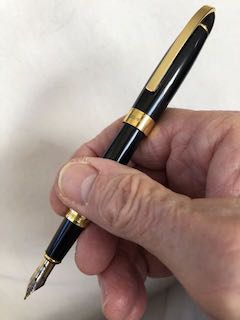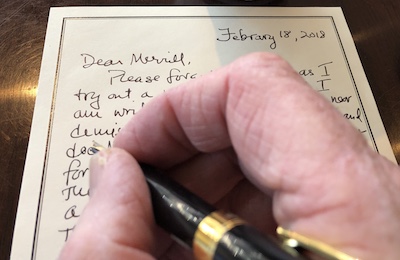Order McKenzie books online with a credit card
Bring Jamie to your school or district for a great workshop.
March Issue
Vol 28|No 4|March 2018

The near demise
|
First Class Mail is Doomed. Get Over it. Forbes -- February 15, 2013, Mark Rogowsky
Consider that in 2002, there were 102.4 billion First Class letters delivered across the United States, but in 2012, that had fallen to just 73.5 billion -- a stunning 28% drop in just a decade. For a parallel, you could look to another victim of the times, the landline phone. In 2003, the Centers for Disease Control conducted its first study of wireless only homes and found 3% had dropped the landline. Today, that number is 34%.
Everything in First Class has left the category faster than anticipated. Bills, payments and general business correspondence have gone online. Personal letters? Obviously, they're nothing but a quaint anachronism. |

The Post Office reports "Total First-Class Mail Volume for 2016 was 61.2 Billion."
This decline is understandable as email and online services offer speed, immediacy and convenience, but this article suggests holding on to what Rogowsky argues above is "nothing but a quaint anachronism." Schools should help students to understand the power of certain older technologies to deliver genuinely caring, intimate messages that new technologies may not be able to match.
They might not send handwritten cards or letters often, but they should know that when they do make this choice, the recipient is likely to value their message far more than they would if transmitted digitally. In some cases, their card or letter will be treasured - saved and read many times.
The love letter, the sympathy card
and the letter of appreciation
While first class mail has declined dramatically, Americans still buy lots of greeting cards to mark special occasions like birthdays, to express sympathy or to proclaim love. Many people pick a card that contains a message that fits the occasion and do little more than sign their names at the bottom. This is all well and good much of the time, but we want our students to understand the power of adding their own words written longhand, and if possible, in script.
This type of communication becomes especially apt when writing a love letter, a sympathy card or a letter of appreciation.
About Greeting Cards
General Facts from the Greeting Card Association
|
Why longhand and script?
If someone writes with a good ballpoint pen (one whose ink flows) or a fountain pen, the message comes through as being more personal than it would if typed or sent as an email. This is because each person's "line" is unique to them. How one forms words, letters and sentences can say a great deal about character, mood and feelings, as is explained in detail by many Web sites devoted to handwriting analysis like http://www.handwriting-graphology.com/handwriting-analysis-chart/
This site claims that "You can know intelligence types, logic, social, verbal, emotional, attitude to money, to sexuality and the feelings or attractions towards other people, to loyalty, and everything is not said and persons are." (not to mention grammar, in this case, LOL)
"You can analyze your writing according to form, pressure, size, slant, zones (upper, middle and lower zones), t bars, layout (margins and spaces between letters, words and lines) and more in our website."
Because when students are in middle school and high school, their own style of handwriting is still developing, it pays to make them conscious of this development so they will work to establish a consistent style that matches their personality. Visits to graphology sites like the one above can help raise student awareness.
The carefully crafted, handwritten love letter, sympathy card or letter of appreciation will make a stronger impression than something that is dashed off or sent by email.
In addition to personalized, stylistically pleasing, intimate handwriting, well chosen words coming from the heart will add to the impact of the message far more than the commercially printed words of a greeting card.
We want our students to realize that sometimes the older technologies may have advantages over the new ones.
Written materials, art work and photography on this site are copyrighted by Jamie McKenzie and other writers, artists and photographers. Written materials on these pages may be distributed and duplicated if unchanged in format and content in hard copy only by school districts and universities provided there is no charge to the recipient. They may also be e-mailed from person to person. All other uses, transmissions and duplications are prohibited unless permission is granted expressly. Showing these pages remotely through frames is not permitted. FNO is applying for formal copyright registration for articles.
|
